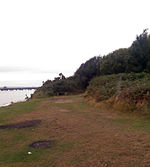Hook with Warsash

Hook with Warsash is a 251.6-hectare (622-acre) Local Nature Reserve west of Fareham in Hampshire. It is owned by Hampshire County Council and managed by Hampshire Countryside Service. It is part of Solent and Southampton Water Ramsar site and Special Protection Area, of Solent Maritime Special Area of Conservation, and of Lee-on-The Solent to Itchen Estuary Site of Special Scientific Interest.This nature reserve on the banks of the River Hamble and Southampton Water has diverse habitats, intertidal mud, saltmarsh, grazing marsh, reedbed, scrapes, shingle and woodland. Flora include sea kale, yellow horned poppy, slender hare's ear, marsh marigold, English stonecrop and wild carrot.
Excerpt from the Wikipedia article Hook with Warsash (License: CC BY-SA 3.0, Authors, Images).Hook with Warsash
Hook Park Road,
Geographical coordinates (GPS) Address Nearby Places Show on map
Geographical coordinates (GPS)
| Latitude | Longitude |
|---|---|
| N 50.843 ° | E -1.3 ° |
Address
Hook Park Road
Hook Park Road
SO31 9HA , Fleetend
England, United Kingdom
Open on Google Maps










